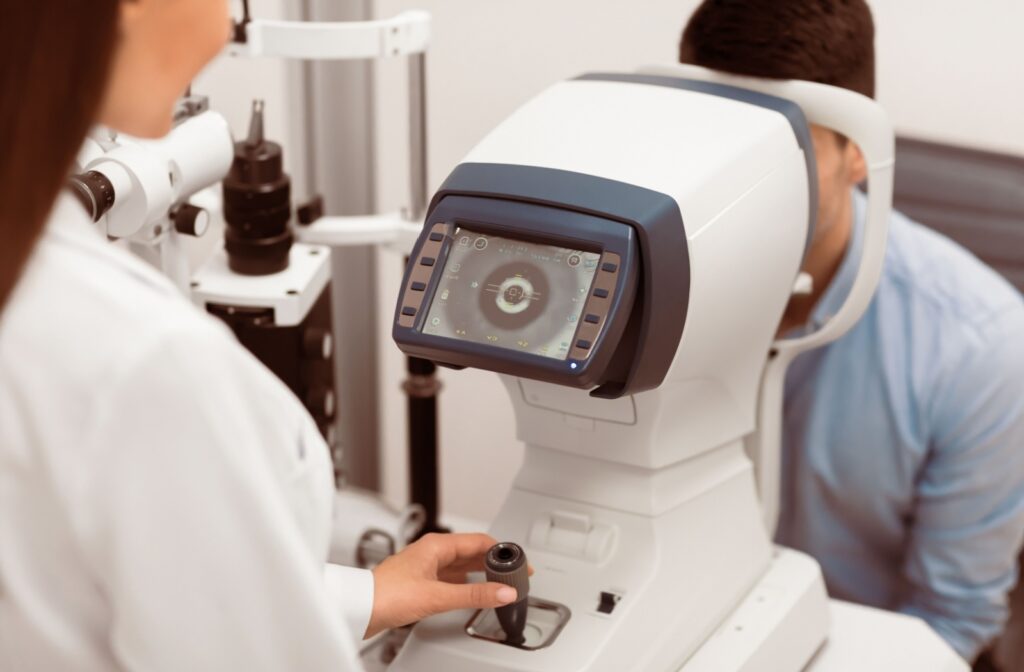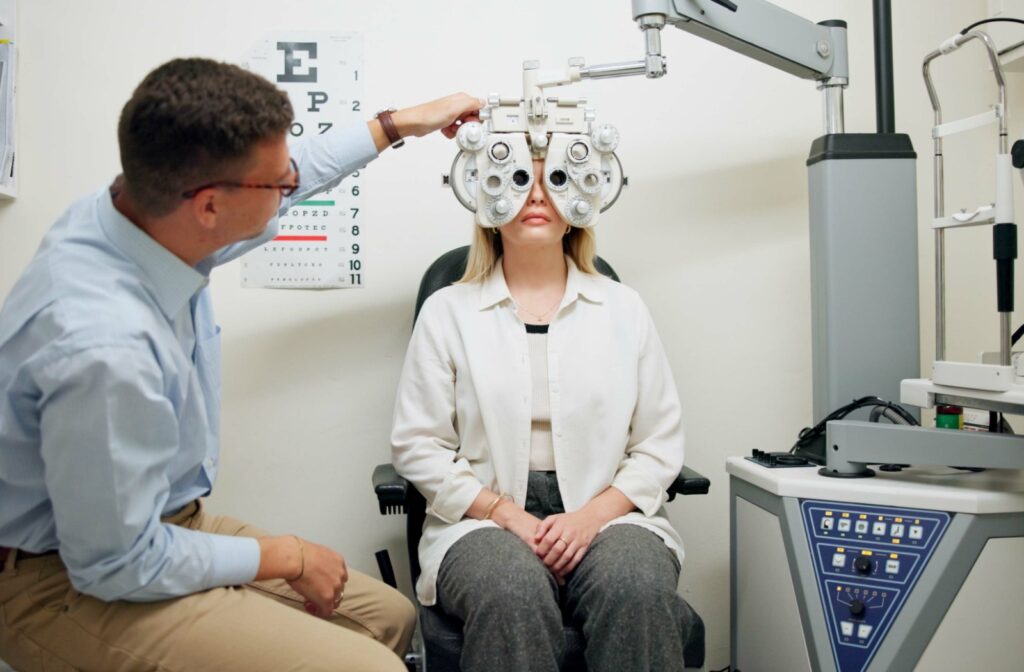A comprehensive eye exam goes beyond checking how well you can see. It’s a comprehensive medical evaluation that assesses your entire visual system and eye health. From diagnosing refractive errors to detecting early signs of disease, eye exams are an essential part of preventive care.
Unlike a simple vision screening, which typically checks visual acuity, a comprehensive eye exam involves several procedures and tools designed to provide a complete picture of eye function and overall health. Understanding the differences between exam types helps clarify why regular visits to an optometrist are so important.
Types of Eye Exams
Not all eye exams serve the same purpose. While they may overlap, the goals and scope vary. Identifying which exam is needed depends on your symptoms, age, medical history, and risk factors.
Routine Vision Exam
A routine vision exam often involves:
- Checking visual acuity using an eye chart
- Identifying refractive errors like nearsightedness, farsightedness, astigmatism, or presbyopia
- Providing a glasses or contact lens prescription
This exam may also include a quick screening of the eye’s surface and internal structures, but it typically does not assess the retina or optic nerve in detail. For that, a more in-depth evaluation is necessary.
Contact Lens Exam
If you wear or want to wear contact lenses, a contact lens exam is a required step. This type of exam includes:
- Measuring the curvature of the cornea
- Evaluating tear film quantity and quality
- Determining which contact lens type is best suited for your eyes
Specialty lenses, such as scleral lenses and RGP lenses (rigid gas permeable), may be recommended for those with dry eye disease or corneal conditions like keratoconus. These lenses provide more comfort and stability by vaulting over the cornea and resting on the sclera, the white part of the eye.
Dry Eye Evaluation
Dry eye symptoms can affect both vision and comfort. A dedicated dry eye evaluation may include:
- Imaging of the meibomian glands, which help produce the oily layer of the tear film
- Measuring tear breakup time and tear volume
- Reviewing symptoms like burning, watering, or a gritty sensation
Technologies like OptiLight IPL therapy offer noninvasive treatment options. This type of light-based therapy targets inflammation, helping improve tear function in patients with meibomian gland dysfunction. It’s especially valuable for those who have not responded to conventional eye drops or warm compresses.
What Happens During a Comprehensive Eye Exam
A comprehensive eye exam involves several diagnostic steps designed to evaluate vision, detect diseases, and document any long-term changes. It’s also a valuable opportunity to assess how technology and lifestyle may be affecting eye health.

Medical History & Symptom Review
The exam often begins with a discussion about:
- Current symptoms
- Medical history and medications
- Family history of eye disease
This information helps guide the prioritization of which tests.
Visual Acuity Testing
Using standardized charts, this test measures your ability to see clearly at both distance and close range. This determines if glasses or contacts are needed and if a change in prescription is appropriate.
Refraction
This step fine-tunes your lens prescription using a phoropter. The optometrist asks which lens looks clearer as they toggle between options.
Eye Movement & Coordination
Binocular vision testing evaluates how well your eyes work together. The optometrist may check for issues like muscle imbalances or focusing problems, which can contribute to headaches or eye strain.
Intraocular Pressure Measurement
Measuring eye pressure is a key step in identifying early signs of glaucoma. Elevated pressure can damage the optic nerve over time.
Retinal Imaging & Dilation
Technology, such as Optomap ultra-widefield imaging, allows optometrists to view the retina in great detail without discomfort. In some cases, dilation is used to widen the pupil, allowing for a deeper examination of the internal structures of the eye, including the optic nerve, macula, and blood vessels.
Anterior Segment Evaluation
The optometrist uses a slit lamp to examine the front part of the eye. This test can help identify problems such as cataracts, corneal irregularities, or inflammation.
The Role of Technology in Modern Exams
Technology has transformed the way comprehensive eye exams are performed. Clinics equipped with innovative diagnostic tools can detect changes earlier and offer more targeted and comfortable treatment options.
OptiLight, for example, is used in dry eye management and is one of the first technologies of its kind available in the area. Digital retinal imaging, meibography, and corneal topography are other examples of how diagnostic accuracy has improved. Patients can benefit from premium digital progressives, blue light-filtering lenses, and custom-fit contact lenses, all of which are part of the optical experience at modern eye care clinics.
When to Schedule a Comprehensive Exam
Many people schedule eye exams only when they notice a change in their vision. However, regular exams can detect conditions like glaucoma, diabetic retinopathy, or age-related macular degeneration before symptoms appear. Early detection is key to managing these conditions effectively.
The frequency of exams depends on several factors:
- Age
- Risk for eye disease
- Use of corrective lenses
- Presence of health conditions like diabetes or high blood pressure
Children, adults over 40, and people with a family history of eye disease may benefit from more frequent evaluations.
Comprehensive Care in Downtown Boise
Vision One Boise offers patients in the community comprehensive eye care, supported by experienced professionals and innovative diagnostic technology. Their services include dry eye therapy, contact lens fittings for challenging conditions, and support for patients looking to maintain long-term eye health. Whether you’re visiting for your first eye exam or seeking specialized treatment, come visit our optometrists and opticians, who are ready to guide your care.



